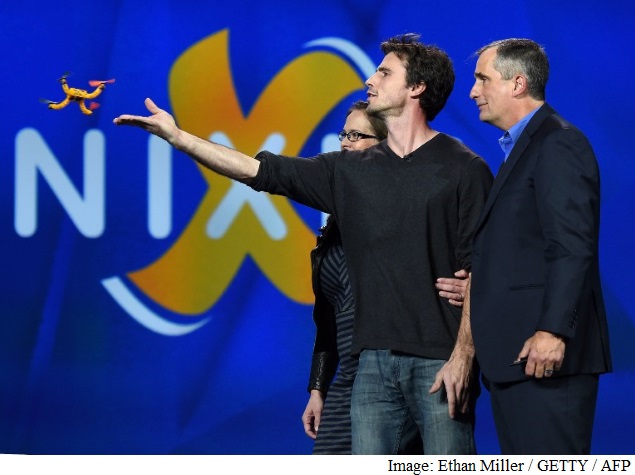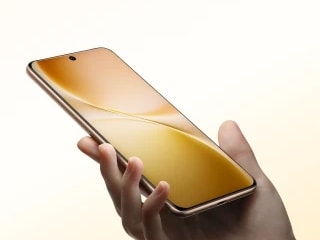- Home
- Wearables
- Wearables News
- Intel Shows Off Curie Wearable Platform, Nixie Drone, and More at CES
Intel Shows Off Curie Wearable Platform, Nixie Drone, and More at CES

Speaking at the Consumer Electronics Show (CES) in Las Vegas on Tuesday, Krzanich also announced a five-year, $300 million (roughly Rs. 1900 crores) investment in math-related education and other programs to help employ more women and minorities in the technology and the video game industries.
Krzanich used most of his keynote to talk up Intel's efforts in computerized apparel and other sensor-packed gadgets - nascent markets that the chipmaker and other technology companies hope will fuel future growth as demand for smartphones and tablets loses steam.
Curie, a new button-sized computer for smart clothes, is due out later in 2015 and includes Bluetooth radio as well as the latest from Intel's Quark line of low-power chips. Intel's chips so far have not made significant inroads into wearable gadgets such as fitness bands or smart watches.
"With this product they can deliver wearables in a range of form factors," Krzanich said of Intel's manufacturing customers. "Rings, bags, bracelets, pendants, and yes, even the buttons on our jackets."
Intel is working with Oakley to launch a smart gadget for athletes later this year, Krzanich said. The chipmaker in December announced it was developing smart glasses with Luxottica, which owns the Oakley brand.
Krzanich demonstrated autonomous flying drones able to navigate around obstacles. He also showed a smaller drone worn on the wrist until it is launched into the air. Called Nixie, the camera-equipped gadget in November won a wearable computing contest sponsored by Intel.
Intel was slow to launch chips for smartphones and tablets, and Krzanich, who took over as CEO in 2013, has made it a top priority to avoid repeating that mistake with future computing trends.
Krzanich announced a goal to reach full representation of women and minorities in Intel's workforce by 2020.
Like most Silicon Valley companies, Intel has a poor track record employing women and some minorities. Just a quarter of Intel's U.S. employees in 2013 were women and 12 percent of its workforce were Hispanic or African American, according to company data.
Last year, the chipmaker found itself in the midst of a controversy over gender equality in the video game industry after it pulled advertising from a gaming website in response to an email campaign.
In a movement that has come to be known as "Gamergate," self-described videogame fans lashed back aggressively online at criticism about sexism in gaming culture. A portion of the responses have come in the form of threats of violence on Twitter against the women in the video game industry.
Intel later apologized and resumed advertising on the gaming website.
© Thomson Reuters 2015
Catch the latest from the Consumer Electronics Show on Gadgets 360, at our CES 2026 hub.
Related Stories
- Samsung Galaxy Unpacked 2025
- ChatGPT
- Redmi Note 14 Pro+
- iPhone 16
- Apple Vision Pro
- Oneplus 12
- OnePlus Nord CE 3 Lite 5G
- iPhone 13
- Xiaomi 14 Pro
- Oppo Find N3
- Tecno Spark Go (2023)
- Realme V30
- Best Phones Under 25000
- Samsung Galaxy S24 Series
- Cryptocurrency
- iQoo 12
- Samsung Galaxy S24 Ultra
- Giottus
- Samsung Galaxy Z Flip 5
- Apple 'Scary Fast'
- Housefull 5
- GoPro Hero 12 Black Review
- Invincible Season 2
- JioGlass
- HD Ready TV
- Laptop Under 50000
- Smartwatch Under 10000
- Latest Mobile Phones
- Compare Phones
- Samsung Galaxy A07 5G
- Vivo Y500i
- OnePlus Turbo 6V
- OnePlus Turbo 6
- Itel Zeno 20 Max
- OPPO Reno 15 Pro Mini 5G
- Poco M8 Pro 5G
- Motorola Signature
- Lenovo Yoga Slim 7x (2025)
- Lenovo Yoga Slim 7a
- Realme Pad 3
- OPPO Pad Air 5
- NoiseFit Pro 6R
- Xiaomi Watch 5
- Acerpure Nitro Z Series 100-inch QLED TV
- Samsung 43 Inch LED Ultra HD (4K) Smart TV (UA43UE81AFULXL)
- Asus ROG Ally
- Nintendo Switch Lite
- Haier 1.6 Ton 5 Star Inverter Split AC (HSU19G-MZAID5BN-INV)
- Haier 1.6 Ton 5 Star Inverter Split AC (HSU19G-MZAIM5BN-INV)

















